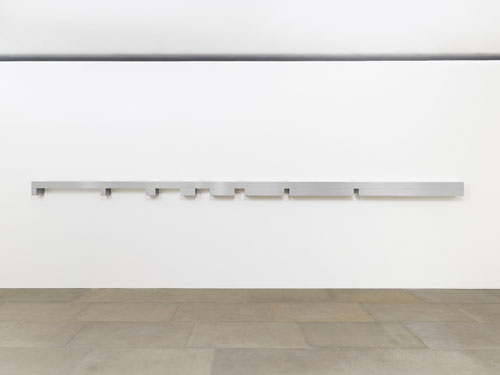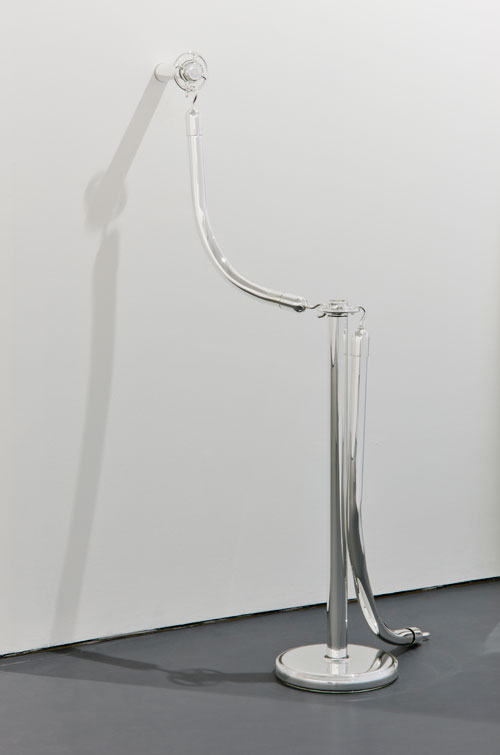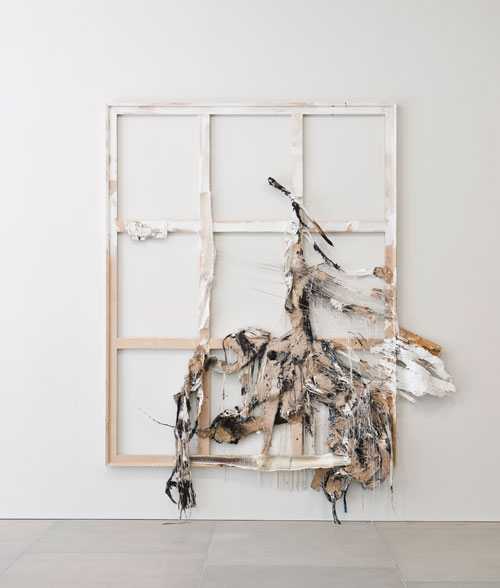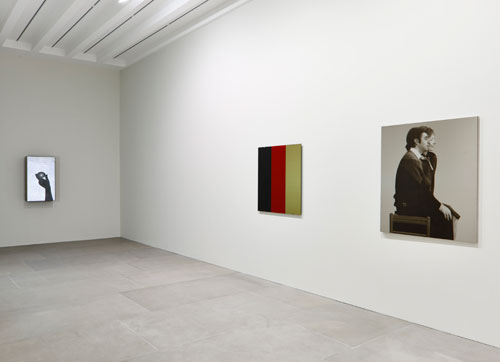

Blain Southern, London
17 July – 27 September 2014
by JANET McKENZIE
In a related context, in Returning to Nothing: The Meaning of Lost Places, Peter Read describes the home as “a site of first attachment, a source of intense pleasure if unhindered, anxiety if threatened and grief if destroyed”. It is “a here from which to discover the world, a there to which we can return”; “A ruined home, especially one of personal association, speaks to almost everyone of change, decay and mutability.”
The Poetics of Space interrogates the meaning of space apropos art and poetry, intimate spaces such as a house or a room, and small parts of them such as furniture, and their position within the wider world of landscape. Through interior domestic space and its components, Bachelard attempts to trace the manner in which the poetic image is received in the subjective consciousness. The disorientation of tragedy or grief also compels the individual artist to redefine his or her place within the void of loss, to rebuild one’s position in life in its solitariness. Bachelard’s notion of the house as the “quintessential phenomenological object” has prompted the exploration by numerous artists as an online search will reveal.
The exhibition at Blain Southern in London this summer represents the opportunity to experience the manner in which artists have explored the relationship between personal experience and space, between the void and emptiness from the 1960s to the present day. Although the exhibition does not present a cohesive survey of the ideas evoked by Bachelard, it includes a number of exceptional pieces by Carl Andre, Donald Judd, Lucio Fontana and Michelangelo Pistoletto, a rare sound piece by Bill Viola, and works by Gerhard Richter and Rachel Whiteread.
Poetry, Bachelard asserts, is directed at one and the same time both inwards and outwards, which the sculpture by Whiteread addresses. In Untitled (Paperbacks), she casts the negative space of a shelf of books evoking both absence and loss. She creates casts of ordinary domestic objects and, in numerous cases, the space the objects do not inhabit (often termed the “negative space”), which she says carry “the residue of years and years of use”.
The most memorable of Whiteread’s works, completed in October 1993 is House, the cast of a Victorian terrace house, a project she conceived in 1991, when she started looking for a house suitable for the project in north and east London. During 1992 and 1993, Whiteread had an artist residency in Berlin; there she created Untitled (Room), the cast of a generic, anonymous room that she built herself. She finished the interior of a room-sized box with wallpaper, windows and door before casting House, exhibited at the location of the original house – 193 Grove Road – in east London (all the houses in the street had earlier been knocked down by the council).
In the context of the present Blain Southern exhibition, Bachelard’s writing is perhaps best explored by Whiteread; this is partly because in viewing her intriguing cast of the bookshelf, the previous work, House is evoked and resonates with the sense of significance between spaces, from a full-sized home to the small aspects of it. The poetic exploration succeeds in evoking Bachelard’s evocation of memory and levels of meaning. An architectural space is thus imbued with layers of meaning: a house is both unified and complex; it is the result of memories and experiences. The house, as the most intimate of all spaces, “protects the daydreamer”, and therefore understanding the house is, for Bachelard, a way to understand the soul.
Carl Andre (b1935) became a leading artist in the emergence of Minimalism in the United States in the mid-60s, making sculptures out of ordinary industrial materials – wood, bricks and metals – arranged on the floor in simple linear or grid-like patterns. Following a visit to Stonehenge at the age of 19, Andre chose to work with the idea of “sculpture as place” rather than the more traditional concept of “sculpture as form”. At Blain Southern, viewers can walk across his beautiful 36 Aluminium Lock Square (1968), the subtle patterning of the metal tiles resembling etching plates, or the patina created through weathering. By removing the sculpture from the traditional plinth, the viewer can occupy the mental space created by the artist through touch.
Donald Judd (1928-94) was one of the most influential artists in America in the second half of the 20th century. Minimalist art in America came about as a reaction to the romantic exuberance of Abstract Expressionist painting. Numerous other references from American culture can be found expressing simplicity in architecture and design. Society in the 60s was characterised by the polarity of individual expressionism versus the inescapable demands of society. Minimalism was a counter to a form of television-inspired narcissism; it was a high-minded form of individualism – a reaction to the conformity and personal sacrifice required during and after the second world war. Minimalism was deeply sober at a time when a great conflict existed over questions of personal liberty, highlighted by the Vietnam war. Issues of civil rights and government doctrine brought issues such as racism, feminism and the legitimacy of institutions into question.
Judd made his early sculptures himself; they were makeshift and rudimentary, before he enlisted professional fabricators to produce most of his work, under his supervision. Against the dramatic and effusive (and culturally dominant) Abstract Expressionism works of the same period, Judd’s work was described, by Harold Rosenberg among others, as boring. What continues to surprise, in fact, is the immediacy of his work, whether one is looking at an early piece such as that in the present show, or one of the large, factory-made works that followed. Judd himself was in no doubt of his aims. He wanted the viewer to be cleansed of the usual preoccupations of a work of art, “of falsely climactic emphases, of susceptibility to tricks of illusionism, and of the restless drive to penetrate behind ‘mere’ appearances”.
Bill Viola: Presence (1995) was first exhibited at the 46th Venice Biennale, voices from early childhood to old age, barely audible in the stairwell at the gallery, secrets, personal stories within the architectural space.
Bill Viola: Frustrated Actions and Futile Gestures at Blain Southern last summer revealed that almost all of Viola’s work can be defined as “museum-scale”. His video works assume the grandeur of large painterly canvases or the monumentality of sculpted marble, while exploiting the most distinctive qualities of the moving image. Viola’s video works possess both directness and the timelessness of events in an increasingly unpredictable world; the process of engagement is always unsettling, yet always provides an element of revelation.
Reference
1. culturalstudiesnow.blogspot.co.uk/2011/06/gaston-bachelard-poetics-of-space.html


.jpg)

,-1992.jpg)
